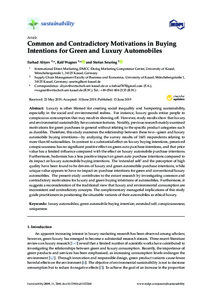Aufsatz

Common and Contradictory Motivations in Buying Intentions for Green and Luxury Automobiles
Abstract
Luxury is often blamed for creating social inequality and hampering sustainability, especially in the social and environmental realms. For instance, luxury goods entice people to conspicuous consumption that may result in showing off. However, study results show that luxury and environmental sustainability have common features. Notably, previous research mainly examined motivations for green purchases in general without relating to the specific product categories such as durables. Therefore, this study examines the relationship between these two—green and luxury automobile buying intentions—by analyzing the survey results of 1601 respondents relating to more than 60 nationalities. In contrast to a substantial effect on luxury buying intentions, perceived conspicuousness has no significant positive effect on green auto purchase intentions, and that price value has a limited influence compared with the effect on luxury automobile purchase intentions. Furthermore, hedonism has a less positive impact on green auto purchase intentions compared to its impact on luxury automobile buying intentions. The ‘extended self’ and the perception of high quality have been found to be drivers of luxury and green automobile purchase intentions, while unique value appears to have no impact on purchase intentions for green and conventional luxury automobiles. The present study contributes to the extant research by investigating common and contradictory motivations for luxury and green buying intentions of automobiles. Furthermore, it suggests a reconsideration of the traditional view that luxury and environmental consumption are inconsistent and contradictory concepts. The complementary managerial implications of this study guide practitioners in positioning the situatable variants of their automobiles as ethical luxury.
Citation
In: Sustainability Volume 11 / Issue 12 (2019-06-13) , S. 3268 ; ISSN 2071-1050Sponsorship
Gefördert durch den Publikationsfonds der Universität KasselCitation
@article{doi:10.17170/kobra-20190910675,
author={Aliyev, Farhad and Wagner, Ralf and Seuring, Stefan},
title={Common and Contradictory Motivations in Buying Intentions for Green and Luxury Automobiles},
journal={Sustainability},
year={2019}
}
0500 Oax 0501 Text $btxt$2rdacontent 0502 Computermedien $bc$2rdacarrier 1100 2019$n2019 1500 1/eng 2050 ##0##http://hdl.handle.net/123456789/11307 3000 Aliyev, Farhad 3010 Wagner, Ralf 3010 Seuring, Stefan 4000 Common and Contradictory Motivations in Buying Intentions for Green and Luxury Automobiles / Aliyev, Farhad 4030 4060 Online-Ressource 4085 ##0##=u http://nbn-resolving.de/http://hdl.handle.net/123456789/11307=x R 4204 \$dAufsatz 4170 7136 ##0##http://hdl.handle.net/123456789/11307
<resource xsi:schemaLocation="http://datacite.org/schema/kernel-2.2 http://schema.datacite.org/meta/kernel-2.2/metadata.xsd"> 2019-09-10T13:16:15Z 2019-09-10T13:16:15Z 2019-06-13 doi:10.17170/kobra-20190910675 http://hdl.handle.net/123456789/11307 Gefördert durch den Publikationsfonds der Universität Kassel eng Urheberrechtlich geschützt https://rightsstatements.org/page/InC/1.0/ luxury automobiles green automobile buying intention extended self conspicuousness uniqueness 330 Common and Contradictory Motivations in Buying Intentions for Green and Luxury Automobiles Aufsatz Luxury is often blamed for creating social inequality and hampering sustainability, especially in the social and environmental realms. For instance, luxury goods entice people to conspicuous consumption that may result in showing off. However, study results show that luxury and environmental sustainability have common features. Notably, previous research mainly examined motivations for green purchases in general without relating to the specific product categories such as durables. Therefore, this study examines the relationship between these two—green and luxury automobile buying intentions—by analyzing the survey results of 1601 respondents relating to more than 60 nationalities. In contrast to a substantial effect on luxury buying intentions, perceived conspicuousness has no significant positive effect on green auto purchase intentions, and that price value has a limited influence compared with the effect on luxury automobile purchase intentions. Furthermore, hedonism has a less positive impact on green auto purchase intentions compared to its impact on luxury automobile buying intentions. The ‘extended self’ and the perception of high quality have been found to be drivers of luxury and green automobile purchase intentions, while unique value appears to have no impact on purchase intentions for green and conventional luxury automobiles. The present study contributes to the extant research by investigating common and contradictory motivations for luxury and green buying intentions of automobiles. Furthermore, it suggests a reconsideration of the traditional view that luxury and environmental consumption are inconsistent and contradictory concepts. The complementary managerial implications of this study guide practitioners in positioning the situatable variants of their automobiles as ethical luxury. open access Aliyev, Farhad Wagner, Ralf Seuring, Stefan doi:10.3390/su11123268 publishedVersion ISSN 2071-1050 Issue 12 Sustainability 3268 Volume 11 </resource>
The following license files are associated with this item:
Urheberrechtlich geschützt

